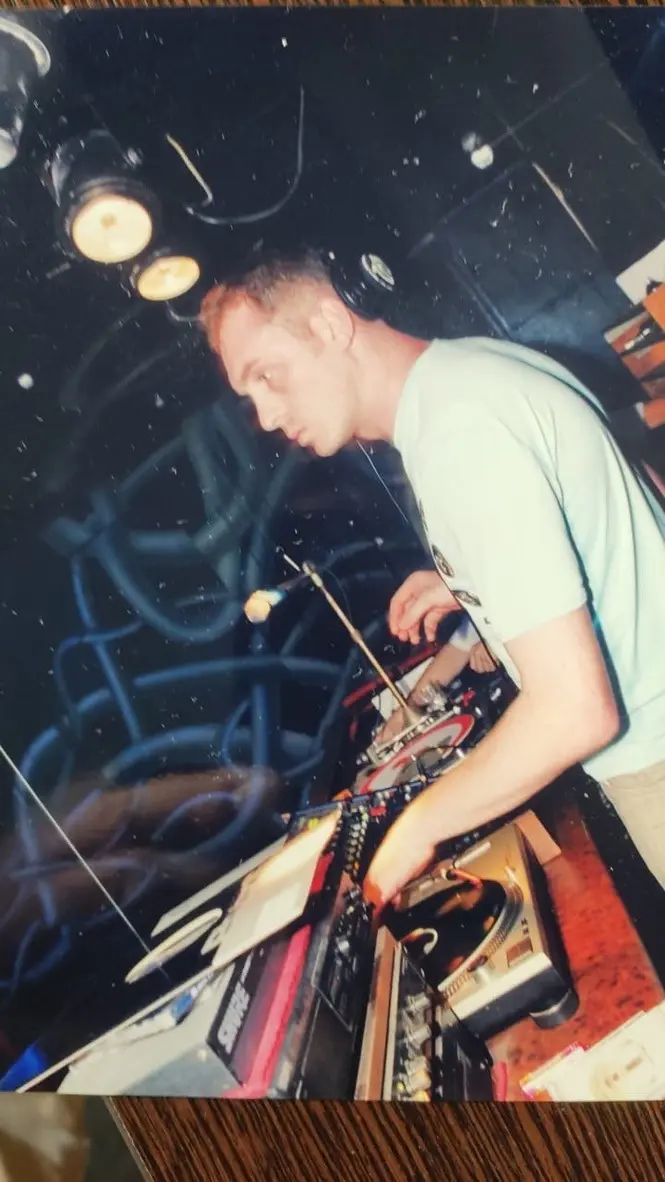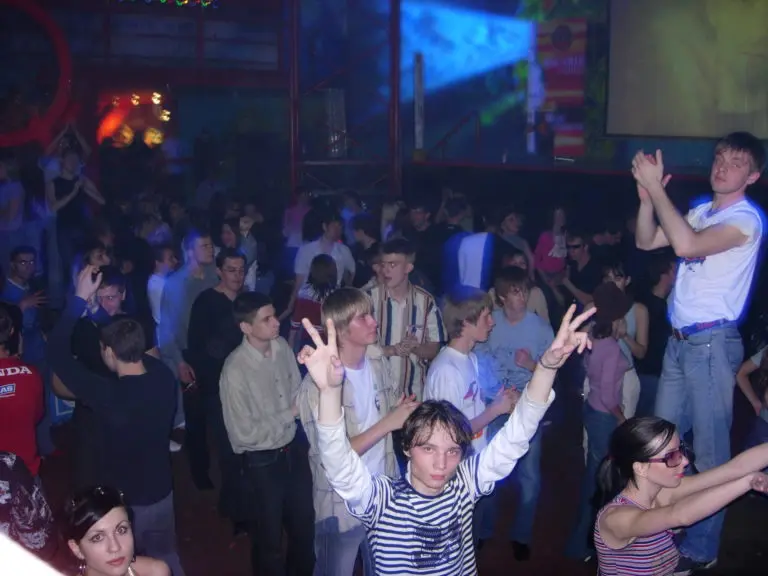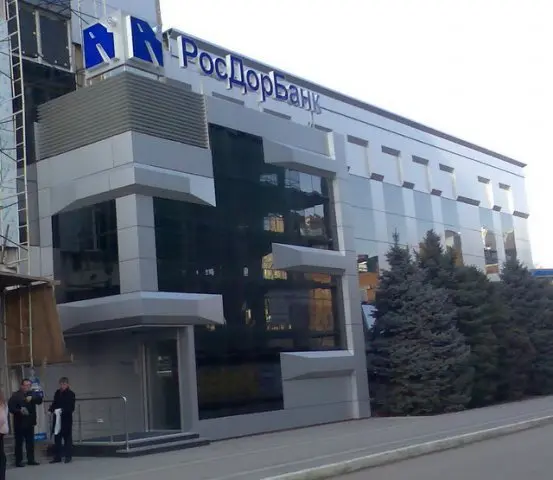In Krasnodar you can often see cars with a dancing Rastafarian enclosed in a stylized letter “Q” on the rear window. Anyone who lived in the regional center in the mid-90s – early 2000s will easily recognize the logo of Quadro, the first large-scale club project of the city. The grandiose parties that took place within its walls are still remembered by the club’s regulars, despite the fact that this dance floor has not been there for almost 17 years.

The name appeared thanks to the inscription on the door handle
Quadro has an army of fans. Thousands of people are subscribed to the club’s official page on only one of the social networks. A lot of fan accounts are also active. There, fans post photos with their tattoos dedicated to Quadro. There is still an official website of the club. This page reflects well the web capabilities of that time when the Internet was just entering the life of Russians. Annually on the birthday of the club, parties are held in the city with the participation of DJs and residents of the project.
The official opening of Quadro took place on February 10, 1995 in the former assembly hall of the Institute “Krasnodargrazhdanproekt”. At the dawn of its existence, this venue was just an ordinary disco, dominated by popular dance music. “Blestyaschie”, Linda, Lada Dance, Vladimir Kuzmin and many other popular Russian artists came here on tour. The first residents of the club were DJ Say and DJ Inzhir – masters of the old formation, who combined the playback of melodies with the role of MC.
— According to the memories of Dmitry Inzhirobyan (DJ Inzhir), the name of the club couldn’t come up for a long time. It was born quite by chance, shortly before the opening, when, leaving the venue, the organizers noticed the word engraved on the handle of the entrance door
— says one of the Quadro’s residents, DJ Ostap.
The musical transformation of the club, which made it famous, occurred with the arrival of a new project manager Dmitry Korolchuk. Just then the unique format began to crystallize, which is now kept in the hearts of thousands of fans of the legendary dance floor.
At that time, Krasnodar DJ Utah M. Paul visited New York, where he plunged into the nightlife of one of the world’s club capitals. He returned to Krasnodar with new CDs and with an idea of how the club industry should develop in the south of Russia.
— In the second half of the 90s, the club’s DJs were not limited in their creativity, on the contrary, they were well funded for any interesting ideas. Now, when we, as artists, are left to ourselves and have to perform a lot of routine organizational functions, to be honest, I’m a little bit nostalgic for those magical times when, without worrying about any numbers, we could engage in pure creativity with the support of a large and well-coordinated team.
— notes DJ Ostap.

You could hear who was playing a couple of blocks away
The sound and light in the club were branded. Nothing like this has been seen in the south of Russia until then. A fortune was spent for the equipment at that time. Several containers of specialized hardware were delivered from the UAE, and a DJ was invited from the UK, who was supervising the setup of the hardware, as well as training disc-jockeys.
— Already a couple of blocks away from the club, it was heard how a qualitatively tuned sound system was “pumping”. The powerful and at the same time transparent sound attracted connoisseurs of electronic dance music from different cities of the country,
— recalls Krasnodar stylist and promoter Vladimir Gayaev.
— In those years, not only the Internet, even pagers didn’t exist yet. It was extremely difficult to find fresh music, and therefore listening to a high-quality DJ-set for Quadro visitors was akin to a revelation. The technologies used in the club have always been advanced. At first, residents were playing on CDs, and later on vinyl players. It was a short but happy period of our creative history when DJs gained real recognition from the public,
— says DJ Ostap.
Electronic dance music dominated the Quadro. Here you could hear the “broken beat”, techno-bombs and a variety of trance. But the house style prevailed. His evolution in the club looked like this: from the anthems of the American label “Twisted America” to the spatial masterpieces of the English label “Global Underground” (DJ Sasha, DJ John Digweed, DJ Dave Seaman, etc.). And exactly English electronic music became the pinnacle of the Quadro’s music format.

Clubbers cried en masse on the dance floor
The line-up of DJs looked like this: the first one started playing from 11:00 PM, the headliner appeared by 01:00 AM at night and the third one started around 03:00 AM. The party lasted until 05:00-06:00 AM in the morning. The whole line-up was built as one multi-hour dramatic line with its development, apogee and logical conclusion.
As a rule, residents didn’t hurry to leave immediately after their performances, but stayed to support colleagues and analyze their sets. Thanks to this, conscious musical selection took place.
On average there were up to 800 people on a site about 600 square meters in size, but on the days with invited star-DJs up to 1500 guests were packed. The Quadro atmosphere often generated peak states when clubbers cried en masse on the dance floor. People on the dance floor behaved like a single organism, united in a single impulse.
The golden time of the club was in 1997-2001. Then, without a doubt, it was the main dance floor of the south of Russia. People came here to dance from Rostov-on-Don, Sochi, Stavropol, and other cities of the North Caucasus. Such famous Russian artists as DJ Fonar, DJ Fish and DJ Spyder, DJ Compass-Vrubel, DJ Slava Finist and many others performed here.
Such music was much more expensive
By 1999, rave culture in Krasnodar had become a separate direction. Quadro’s resident-DJs began to release copies of their own CDs. These compilations were in great demand among music lovers and, by the way, such music was much more expensive in the music stores of the city.
— I remember very well the very first CD that came out. The yellow cover, on which was written “Quadro First Utah Utah 1997”. There was a track “Fired Up” by Funky Green Dogs. After the release of the disc, it sounded in all fashionable Krasnodar advertisements of that time,
— says Gayaev.
Gradually, a whole Quadro formation appeared. Quadro was divided into themed parties that took place on a certain day. Wednesday – Staff party. Thursday – pleasant music, with a slight background. Entrance for girls was free. On the same day, young talents performed their sets trying to declare themselves in the club. The underground music was played on Friday. Invited guests performed on Saturday.
— At first I was a resident of another Krasnodar disco and, to be honest, I was skeptical about the club culture. Every Thursday, aspiring DJs could perform in Quadro. Once DJ Ostap invited me to play that day. I tried it and I liked it. After that, the art director of the club, Igor Romanenko, started putting me to play once a month. Gradually, I began to perform more often, first every Thursday, and then also on Saturday. And in 2000 I became the fifth Quadro resident. Before that, the club was always focused on the number “four”: four speakers on the dance floor, four residents, etc. I was especially pleased that the club made an exception for me,
— says Quadro’s resident DJ Klim.

DJ Ostap is convinced that such a club could hardly appear in any other Russian cities. Quadro harmoniously absorbed elements of American, European and national rave culture, while bringing a special southern spirit. Having reached creative maturity, it eventually became a cultural phenomenon.
— The people who worked at Quadro were a team of professionals. The management team of the club with all of its directors, bartenders, waiters and technical service – absolutely everyone. All of them knew their role and worked for the general energy,
— recalls DJ Ostap.
— A distinctive feature of Quadro – music was always on the pedestal. You could always hear something new on the dance floor. You came to the club and didn’t worry about anything and felt at home. There was literally a family atmosphere here. It was easy to make new contacts. Because of this, there was a unique feeling. Such energy came from a huge number of people, and it was amazing!
— DJ Klim states.
It was scary to approach some guys at parties
Club face-control deserves special attention. At the entrance to the Quardo there were two adult women standing — Olga Alekseevna and Evdokia Kondratyevna. They were respected and feared even by bandits. The women determined who was allowed into the party and who was not. They could deal with a huge bully with a verdict: “Alex, you don’t go to the club today, you’ve fucked up.” And this man obeyed meekly.
About Quadro’s visitors we can say in the words of the founder of the legendary New York club “Studio 54”, Steve Rubell: “Goonies, bandits, politicians and stars could hang out here. No one knew who was who, because everyone in the club was equal.” Representatives of different worlds gathered in Quadro. According to DJs, members of the organized criminal groups, businessmen, politicians, students and even schoolboys were hanging out here. All this motley mass was united by one thing — music.
— It was the harsh 90s. At parties, there were often guys hanging out, to whom in ordinary life it would be scary just to approach. Don’t forget, at that time dancing for a real guy was considered a “shame”. But even people with such principles came to Quadro and danced. It was a paradoxical club that abolished the canonical rules of the street. This place was like a water truce in the jungle from Kipling’s book,
— recalls DJ Ostap.
«I play at Quadro, and my wife is in the hospital, giving birth»
Among those who came to Quadro, there were people who didn’t lead the healthiest lifestyle. According to the DJs of the club, at some point heroin began to arrive in Krasnodar. A large number of clubbers began to use it.
— One day I came to the club and saw such a man with glass eyes. It looked terrible. We fought it in our own way. We announced a series of anti-drug parties. My party was called “Ostap vs Heroin”,
— the DJ recalls.
All events were announced in advance. The party schedule was known a month ahead. The system of production and distribution of flyers was actively working. Posters were printed and pasted around the city. Krasnodar “Radio X” played a significant role in the popularization of parties. Since DJ Ostap worked there, there were usually no difficulties with creating commercials and their maximum broadcast rotation. From 10 to 15 promotional announcements of Quadro parties were broadcast per day.

It wasn’t difficult to find sponsors for the parties. Fashion and sportswear stores, companies producing tonic alcoholic beverages, jewelry stores, etc. were actively cooperating with the club.
— A friend of mine came to Krasnodar in the mid-90s from Tbilisi. Despite the fact that the war had just ended there, the club culture in the Georgian capital was already developed at a high level. The friend told me that Tbilisi clubs negotiate with fashion stores, take models and arrange shows at parties. We decided to transfer this experience to the Krasnodar territory. We went to Quadro’s management and they approved our idea. Then we visited the modeling agency of Elena Morozova. They also supported us: they gave us models with whom we rehearsed the entire program. We have attracted several fashion stores as sponsors. Immediately after the first show, we received a huge amount of offers from other major sellers,
— says Quadro’s art director Igor Romanenko.
In those days, people went to a party as a holiday. They prepared for it, dressed in a special way. And of course, there was a live dance floor. People were rocking. All this created an indescribably strong atmosphere. The club became an integral part of life.
— I remember playing at Quadro. Right during the set, my wife calls me and says that she is already in the hospital, giving birth,
— says DJ Klim.
The best period of club culture
Quadro has existed for 10 seasons. At some point, the club exhausted itself. The format and perception of music have changed. Broken rhythms and minimal became fashionable. And Quadro continued to be the club of house music.
The nightclub closed its doors on February 10, 2005, exactly on the day of its 10th anniversary. Now a bank is located in its place. The room has been completely rebuilt, and nothing in it reminds that once hundreds of people were going full send all night here.

— Quadro made me famous, gave me a lot of emotions, cool sets, datings. Many who have been there remember that time as the best period of Krasnodar’s club culture. Of course I miss Quadro, but I don’t need that anymore. I fully received everything from that time. Even if it was possible to bring everything back, I wouldn’t be able to live like this anymore,
— DJ Klim admits.
By the way, according to the version of Pavel Moskalenko (then DJ Utah Utah, now DJ Utah M. Paul), the dancing Rastafarian in the letter “Q” is not a Quadro’s symbol. This logo was invented by a DJ for his label “Taboo”. The Rastafarian symbolized freedom. The letter “Q” appeared when “Taboo Records” parties began to be held in Quadro.
The editorial board thanks DJ Ostap, DJ Utah M. Paul, DJ Klim, Igor Romanenko, Vladimir Gayaev for their assistance in creating the material.
By the way
Now a separate channel of the Krasnodar online radio station (radiox.tv) is dedicated to the music format of the legendary club. There you can hear the Quadro’s retrospective around the clock.
Opinions
Alexey Aliferov, art director of the Digger Club at the time of Quadro:
“I didn’t like Quadro because, as for me, it was such a bad taste. The music that was played there was all with the word “progressive” – progressive house, progressive trance, etc. It was commercial music, in my opinion, very stupid, which made me want to yawn and feel sick at the same time. People went there because they thought this music was fashionable, because someone told them how popular it was in Europe and the USA. In fact, it wasn’t. At the time of Quadro, we did our own parties, where really modern music was played, which was inspired at that moment in the rest of the world. Of course, I’ve been to Quadro, even played in this club. There were sometimes normal parties, live concerts. For example, the performance of the group “Jah Division”, live DJ Clapan, etc. But on a typical weekend, the same DJs were playing in this club, with a repertoire unchanged for years, an overblown ego and a narrow outlook. It wasn’t my music or my culture.”
Nikolay Petrov, designer, promoter, organizer of alternative parties at the time of Quadro:
“I remember Quadro from the very beginning until its closure. We never held parties there, but I made decorations for the club. The history of Quadro is a classic example of a cult club. When it opened, it was the first. This happened at the time when music was listened to from cassettes. Quadro was not so much a place where some kind of music was promoted, as a club where you can spend time and have fun. The club was visited by cool guys who earned good money and wanted to have a good rest. Then the guys from the outskirts pulled up there. Yes, good DJs were brought to Quadro and good events were held there. But it wasn’t a cultural place. Ravers as a phenomenon didn’t really go there. It was a club for a certain kind of leisure. And this is the normal evolution of any cult club. At first, enthusiasts run it, then the place becomes popular and after that everything turns into commerce.”
Author: Maksim Kulikov
